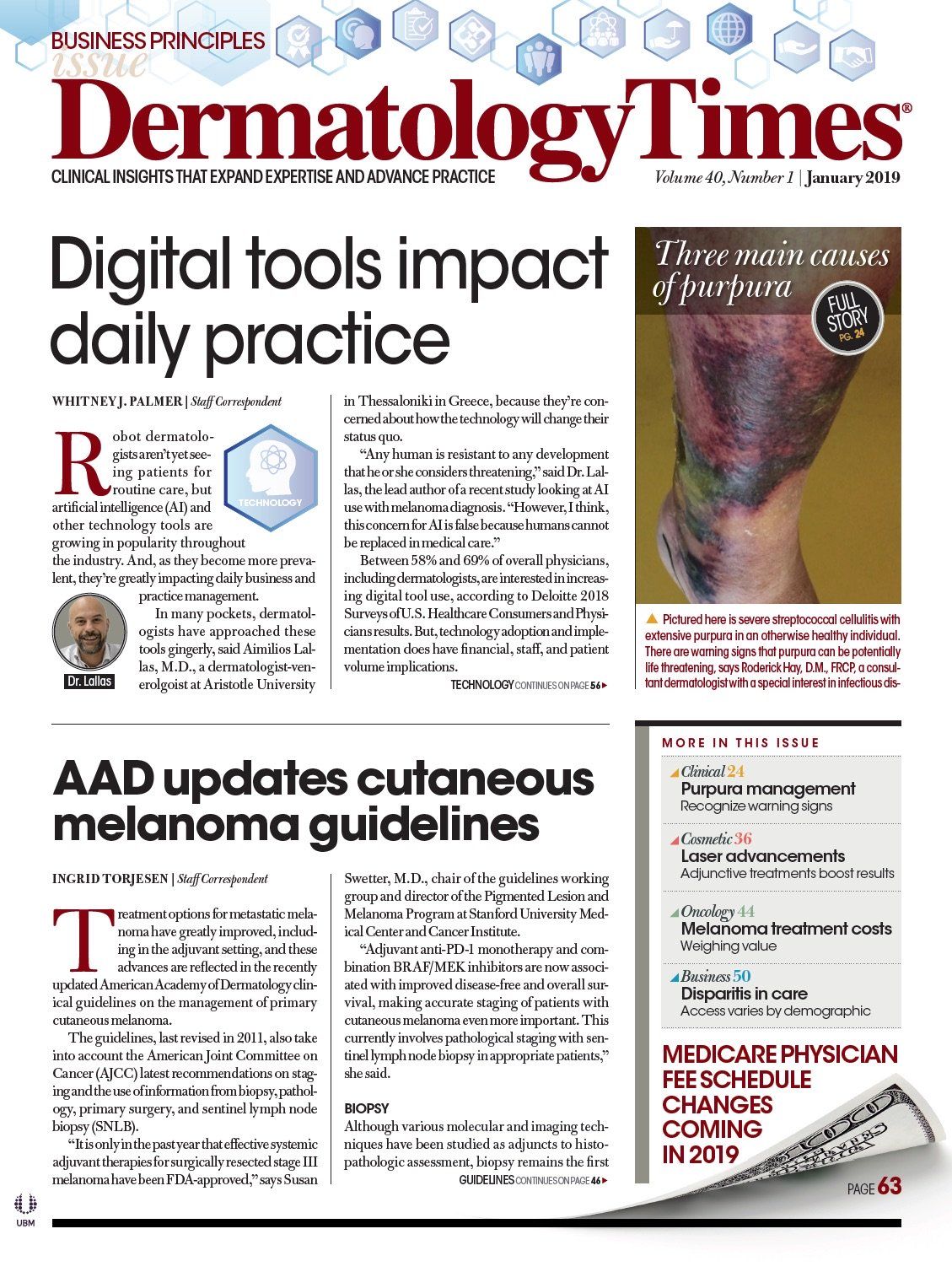- Acne
- Actinic Keratosis
- Aesthetics
- Alopecia
- Atopic Dermatitis
- Buy-and-Bill
- COVID-19
- Case-Based Roundtable
- Chronic Hand Eczema
- Chronic Spontaneous Urticaria
- Drug Watch
- Eczema
- General Dermatology
- Hidradenitis Suppurativa
- Melasma
- NP and PA
- Pediatric Dermatology
- Pigmentary Disorders
- Practice Management
- Precision Medicine and Biologics
- Prurigo Nodularis
- Psoriasis
- Psoriatic Arthritis
- Rare Disease
- Rosacea
- Skin Cancer
- Vitiligo
- Wound Care
Publication
Article
Dermatology Times
Digital tools impact daily dermatology practice
Author(s):
Robot dermatologists aren’t yet seeing patients for routine care, but artificial intelligence (AI) and other technology tools are growing in popularity throughout the industry. Learn more about how these advances in technology are impacting practices.
Between 58% and 69% of overall physicians, including dermatologists, are interested in increasing digital tool use, according to Deloitte 2018 Surveys of U.S. Healthcare Consumers and Physicians results. But, technology adoption and implementation does have financial, staff, and patient volume implications.

Dr. Suzanne Steinbaum

Robot dermatologists aren’t yet seeing patients for routine care, but artificial intelligence (AI) and other technology tools are growing in popularity throughout the industry. And, as they become more prevalent, they’re greatly impacting daily business and practice management.
In many pockets, dermatologists have approached these tools gingerly, said Aimilios Lallas, M.D., a dermatologist-venerolgoist at Aristotle University in Thessaloniki in Greece, because they’re concerned about how the technology will change their status quo.
“Any human is resistant to any development that he or she considers threatening,” said Dr. Lallas, the lead author of a recent study looking at AI use with melanoma diagnosis. “However, I think, this concern for AI is false because humans cannot be replaced in medical care.”
Between 58% and 69% of overall physicians, including dermatologists, are interested in increasing digital tool use, according to Deloitte 2018 Surveys of U.S. Healthcare Consumers and Physicians results. But, technology adoption and implementation does have financial, staff, and patient volume implications.
THE COST OF TECHNOLOGY
According to the Deloitte survey, the cost of technological tools, including AI, electronic health records, or practice management systems, greatly impacts the bottom line for many practices. On average, such systems hover around approximately $60,000.
Although price tags can be an initial adoption and implementation barrier, once in place, these systems can save practices money, research revealed. A recent study published in JAMA Dermatology, evaluated the per-participant cost for individual involved in teledermatology and conventional referral groups. Overall, investigators found teledermatology cost $82 less.
REIMBURSEMENT
Getting paid for providing virtual care can still be complicated. More private insurance companies are beginning to cover these services, but the Centers for Medicare and Medicaid Services (CMS) has different requirements based on whether a patient submits photos and symptom descriptions for a later dermatologist analysis, or if the patient and dermatologist have a real-time conversation. Correct visit coding can ensure payment.
DERMATOLOGIST & STAFF IMPACT
While providers and staff need training to gain proficiency with new technology, practices must guard against technology fatigue, said Suzanne Steinbaum, M.D., director of women’s cardiovascular prevention, health, and wellness at Mt. Sinai Hospital. Providers can experience burnout from too many system launches and optimizations. Practices that both get provider pre-implementation buy-in and ensure their systems are well integrated will have the most success.
Investing in convenience tools, such as online scheduling systems where patients secure appointments themselves, can also increase staff efficiency. They’re freed to tackle other responsibilities, such as helping patients who need more assistance scheduling appointments, transferring prescriptions, or answering more in-office questions.
PATIENT VOLUME
According to the Deloitte survey, 23% of patients have already experienced a virtual visit, and 57% of those who haven’t are willing. Consequently, offering technologies that augment dermatology accessibility is likely to both retain existing and attract new patients.
Additionally, said Maryam Sadeghi, chief executive officer for DermEngine, a dermatology software and workflow improvement company, these tools can also bolster your patient satisfaction scores.
“By using AI tools, dermatologists can change conversations from not knowing exactly what’s going on with the patient,” she said. “Instead, they can tell patients they’ve found multiple patients cases with the same symptoms and successful treatments. This gets a much better response.”
Ultimately, even with business side impacts, industry leaders contend the long-term effects will be beneficial and opting out could have negative results.
“Our view is that, with a changing landscape that favors value-based payment models, growing consumer demand, and advances in digital technologies, virtual care is no longer just a nice-to-have but a must-have for physicians,” the survey authors wrote. “And the time for health systems to consider developing virtual care strategies is now.”

Newsletter
Like what you’re reading? Subscribe to Dermatology Times for weekly updates on therapies, innovations, and real-world practice tips.






























